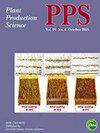遮荫、土壤水分、施肥和播期对北海道大豆种子异黄酮含量的影响
IF 1.3
3区 农林科学
Q2 AGRONOMY
引用次数: 0
摘要
为了在气候凉爽的北海道生产高产、高异黄酮含量的大豆种子,本研究以高异黄酮品种Yukipirika为研究材料,研究了遮荫、土壤水分、钾、氮、磷、钼等施肥和播期对大豆产量和种子异黄酮含量的影响。温室灌种期遮荫50%和70%处理均降低了产量和异黄酮含量。在温室灌种期施用pF 1.5 ~ pF 2.8 4种土壤水分处理,土壤水分与产量和异黄酮含量均呈显著正相关。在北海道高原典型土壤中、高浓度K2O条件下,进行了不同量、不同类型的钾肥处理。在田间试验中,额外施钾对产量和异黄酮含量没有显著提高。田间施氮对产量和异黄酮含量影响不显著。田间施P(施亚磷酸盐根)和Mo(施种子)对大豆异黄酮含量也没有影响。比标准播种时间晚播2周和4周,产量下降,但异黄酮含量没有变化。从实际应用的角度看,北海道生产高异黄酮含量高产大豆种子,应在最低遮荫条件下,按标准时间、正常施肥量种植,灌种阶段保持土壤水分充足。本文章由计算机程序翻译,如有差异,请以英文原文为准。
Effects of shading, soil moisture, fertilizations and sowing time on isoflavone content of soybean seed in Hokkaido
Aiming to produce soybean seeds with high yield and high isoflavone content in Hokkaido, which has cool weather, we evaluated the effects of shading, soil moisture, fertilizations (K,N,P,Mo) and sowing time on yield and seed isoflavone content using mainly a high-isoflavone variety, Yukipirika. Shading treatments of 50 % and 70 % during the seed filling stage in a greenhouse decreased both yield and isoflavone content. Applying four soil moisture treatments from pF 1.5 to pF 2.8 in the seed filling stage in a greenhouse gave a positive correlation between soil moisture and both yield and isoflavone content. K fertilization treatments with different amount and various types of fertilizers were conducted in fields at medium or high level of K2O in soils typical of Hokkaido uplands. The additional K treatments did not increase yield or isoflavone content significantly in the field experiments. N (urea foliar application) treatments in fields did not affect yield and isoflavone content significantly. And P (phosphite root application) and Mo (seed treatment) in fields did not change isoflavone content, either. Sowing two weeks and four weeks later than the standard sowing time in a field decreased the yield but did not change the isoflavone content. From a practical application perspective, for producing soybean seeds with high isoflavone contents and high yield in Hokkaido, it is effective to plant at a standard time with a normal amount of fertilizer in fields with minimum shade and to maintain the soil moisture at well-watered levels during the seed filling stage.
求助全文
通过发布文献求助,成功后即可免费获取论文全文。
去求助
来源期刊

Plant Production Science
农林科学-农艺学
CiteScore
5.10
自引率
4.00%
发文量
27
审稿时长
>36 weeks
期刊介绍:
Plant Production Science publishes original research reports on field crops and resource plants, their production and related subjects, covering a wide range of sciences; physiology, biotechnology, morphology, ecology, cropping system, production technology and post harvest management. Studies on plant production with special attention to resource management and the environment are also welcome. Field surveys on cropping or farming system are also accepted. Articles with a background in other research areas such as soil science, meteorology, biometry, product process and plant protection will be accepted as long as they are significantly related to plant production.
 求助内容:
求助内容: 应助结果提醒方式:
应助结果提醒方式:


